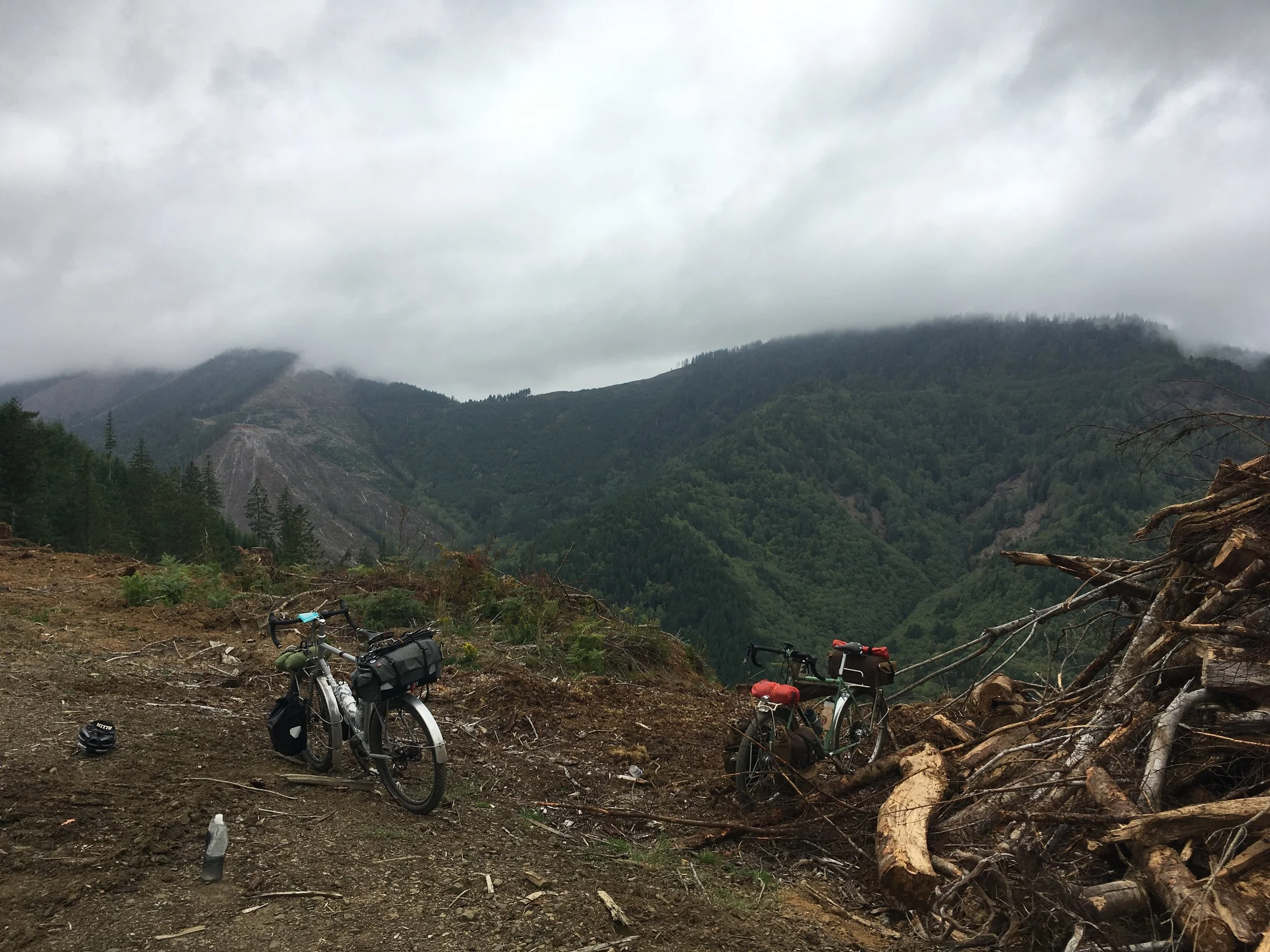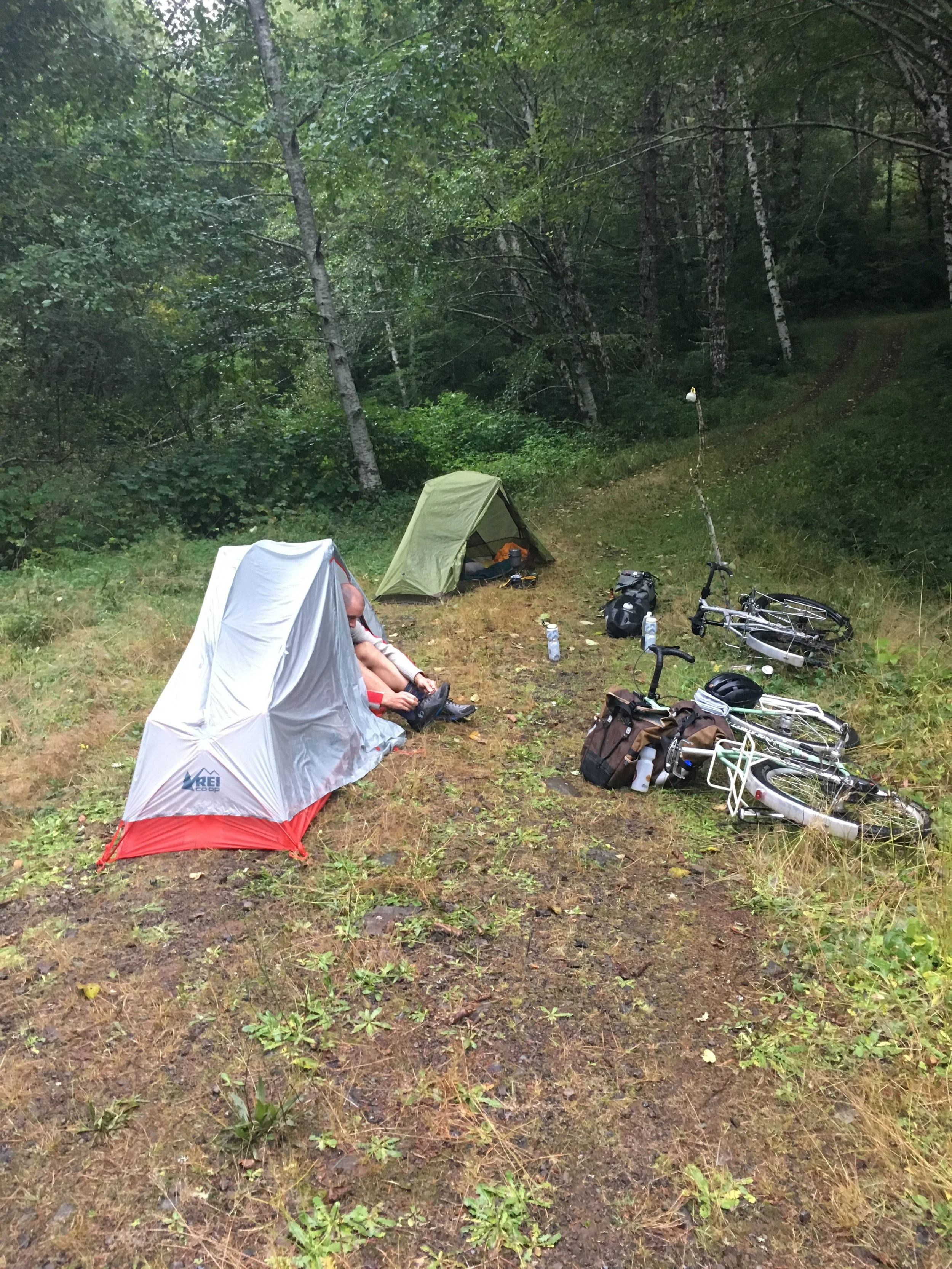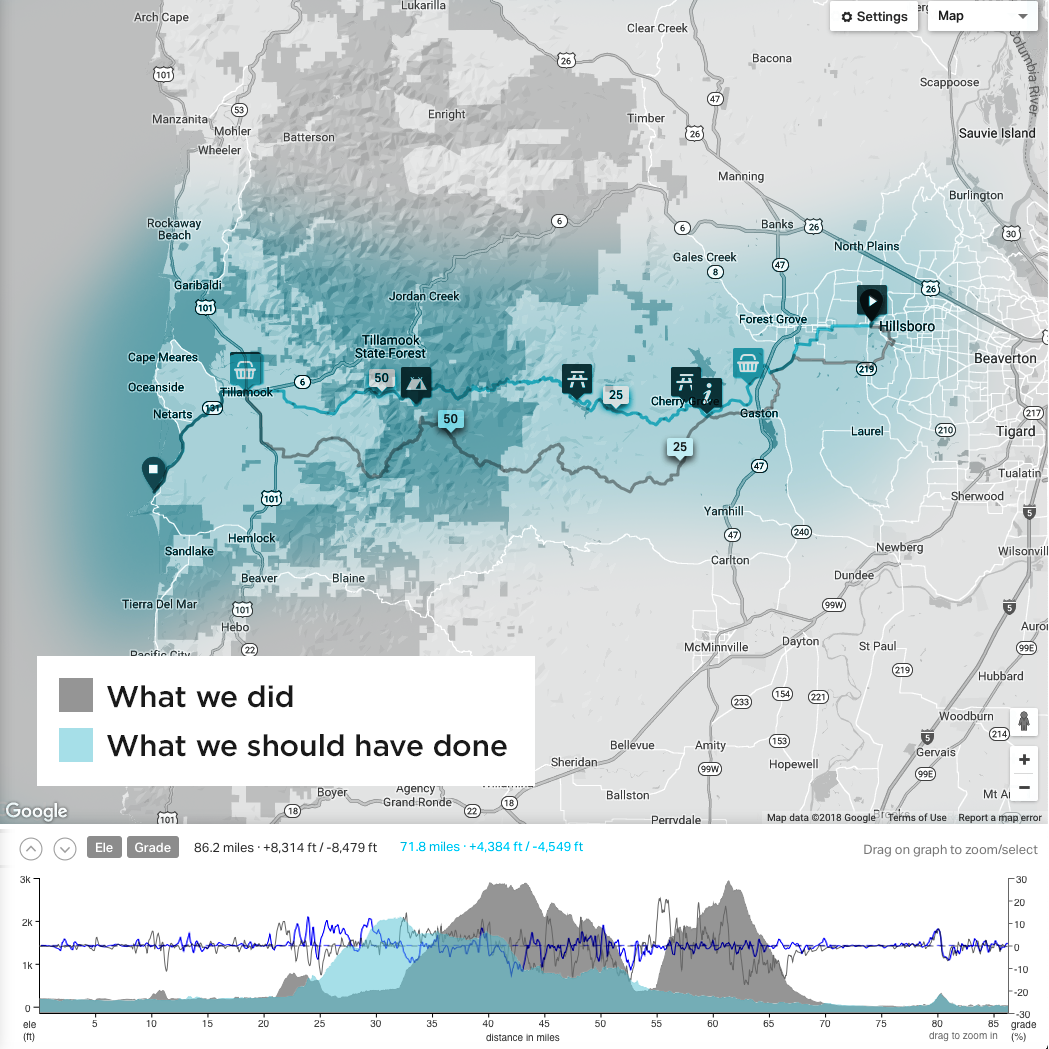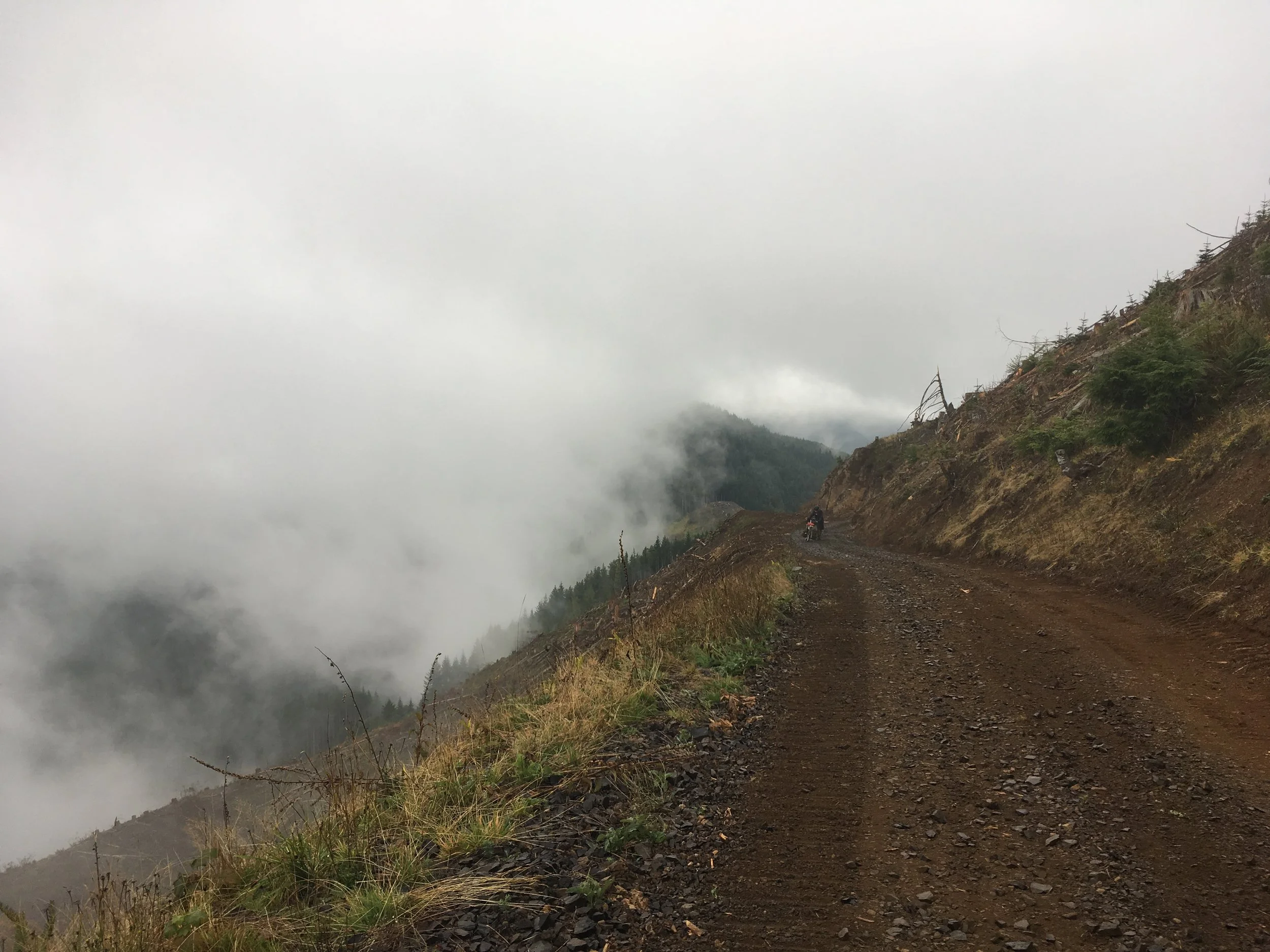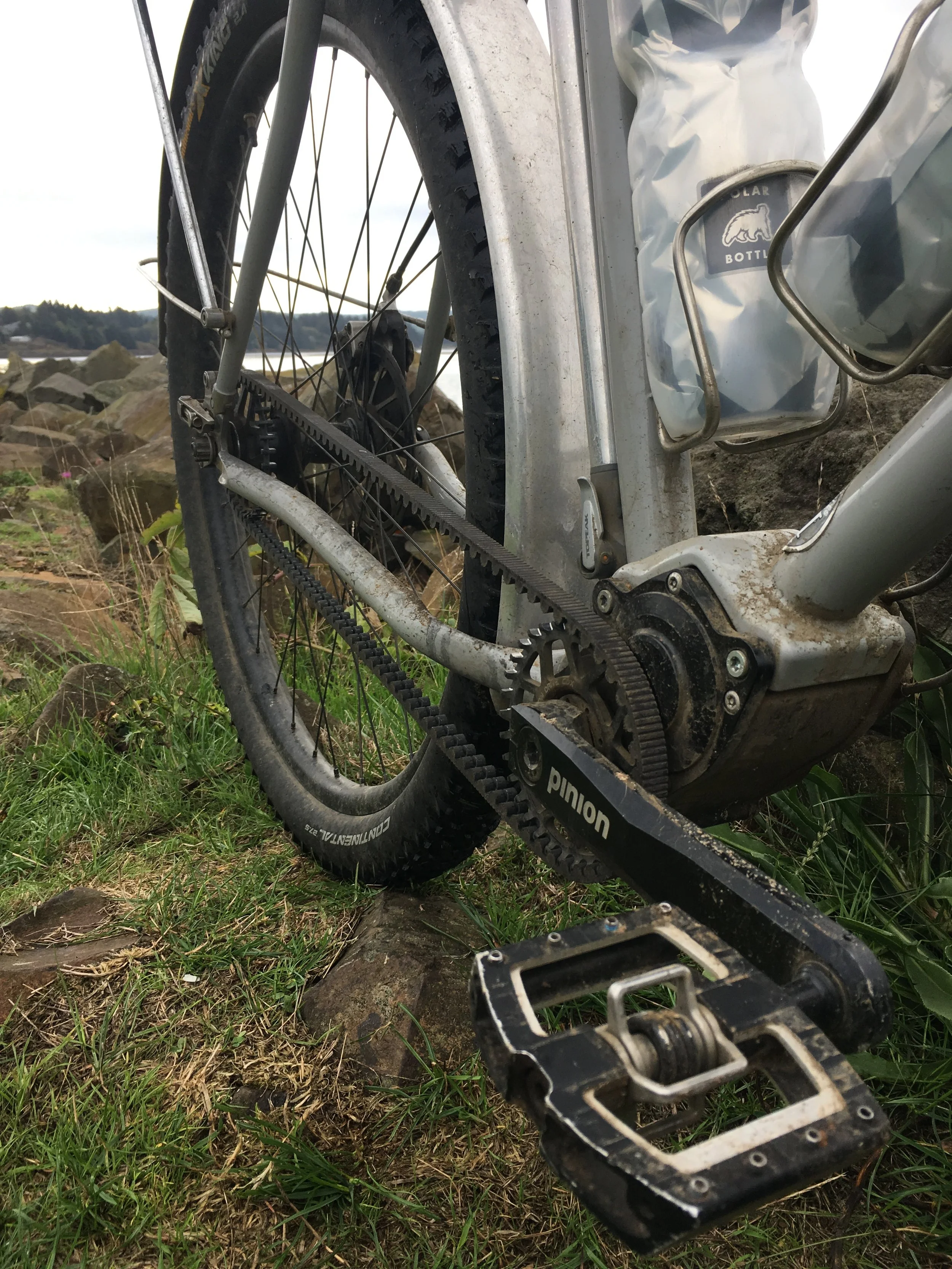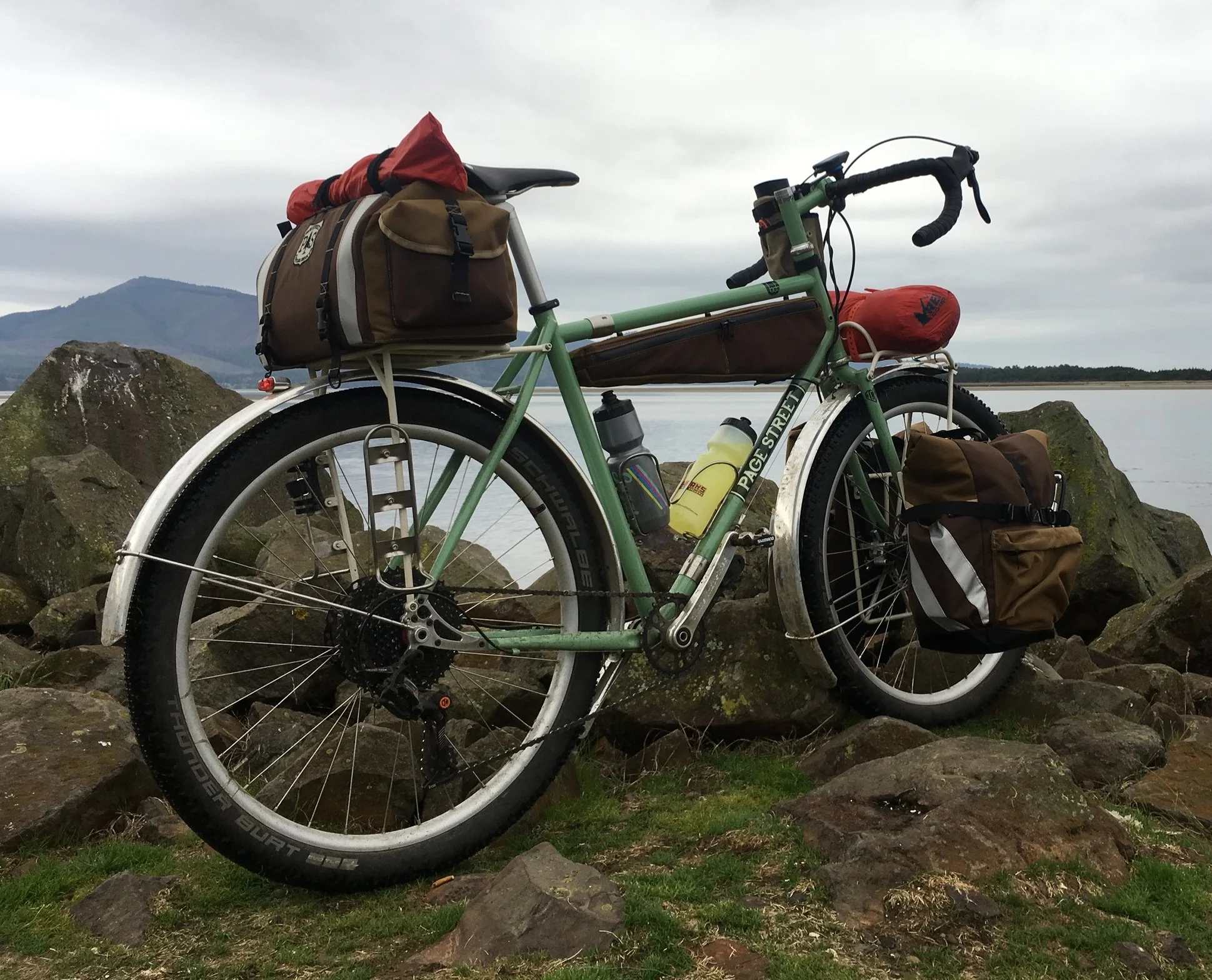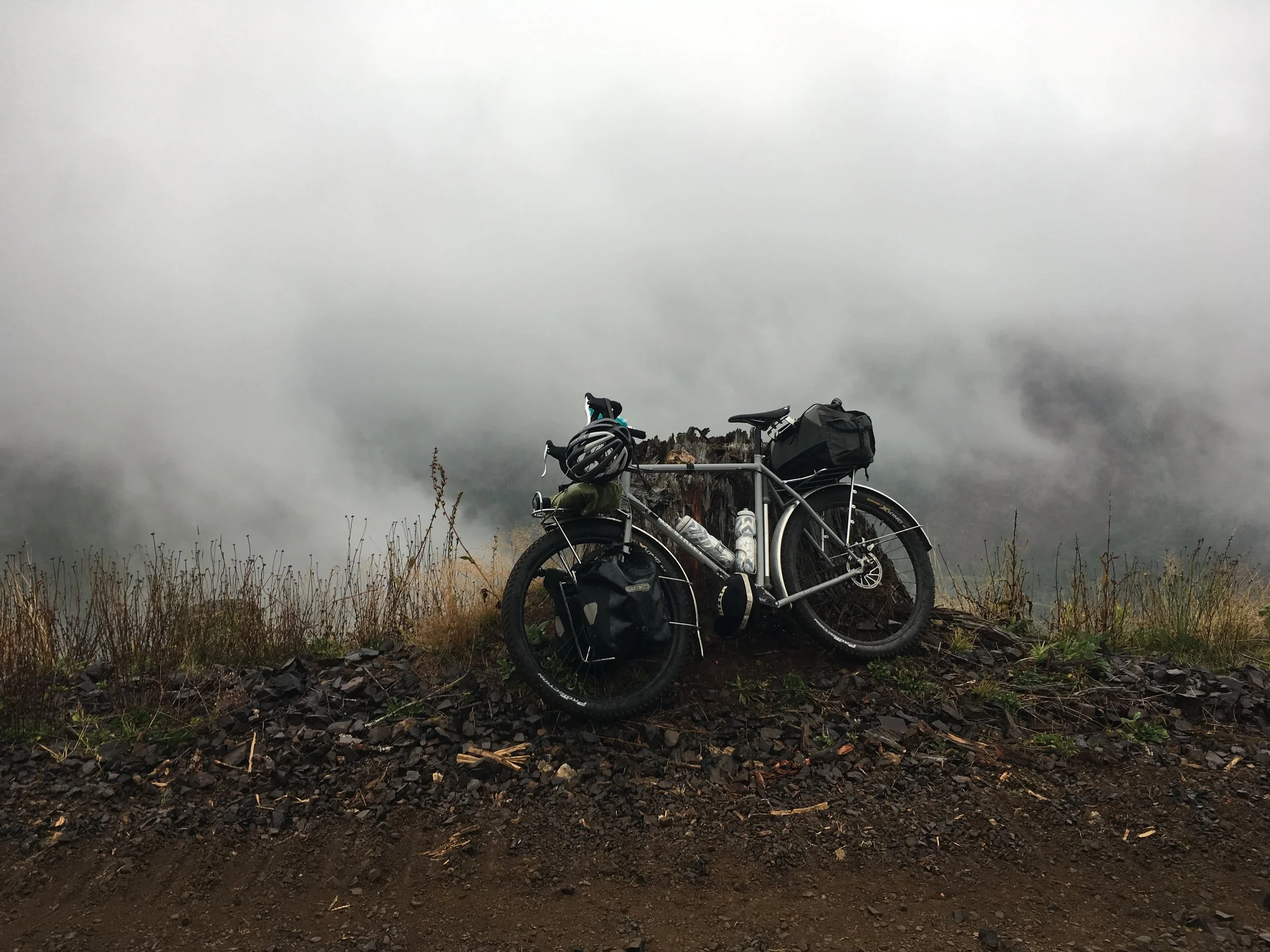Pinion On Netarts Bay
There seems to be a lot of curiosity about the Pinion system.
I’ve recently received several questions from people wanting to know how it functioned on my last bike tour. A couple of weekends back the weather looked promising and Brian and I decided to ride the Trask River Route to the coast. We both have Page Street Outback touring bikes, and we put our bigger, knobby tires on, because most of this route is on gravel, and some of the roads are fairly remote and rocky and unkept.
A quick run-down of the bikes we rode:
My Page Street has the Pinion 18 speed gearbox on it- the P1.18 - and a belt drive system by Gates Carbon Drive.
Brian’s bike has a 1 x 11 chain drive with a Gevenalle shift adapter. He’s got a Box Components derailleur and an 11 - 46T rear cassette. His front cog is a 32T on White Industries cranks (best cranks and rings in the world). We both have Velocity Blunt SS rims, Schmidt SON hubs up front and White Industries CLD or XMR rear hubs, Paul “Klamper” disc brakes. I ran Continental XKing 27.5” x 2.3” tires, and Brian rode Schwalbe “Thunder Burt” tires, both of us riding tubeless.
I only say all this because in many ways our bikes are similar. The main difference being in the drive train: Gearbox vs. Derailleur.
Side Note: Tubeless Touring
Toward the Clouds
I haven’t done much touring on tubeless tires, but after what riding I’ve done, I’m pretty much sold. I’ve been carrying a spare tube with me for a few months now, thinking if I do get a flat, I’ll just put in a tube. But I haven’t yet had any reason to use it. A couple of weeks ago I was on a ride and from the shoulder of a busy country road something punctured my tire pretty seriously. I heard the pop and hiss and as I rolled to a stop I found the hole. Whatever had caused it was no longer lodged in the tire, and I rolled forward until the hole aimed down towards the ground. Sealant bubbled and squirted out for a bit, slowed and then stopped, and I stared at it like, “Uh-uh,” disbelieving a tire could heal itself. But sure enough, even when I refilled the tire with air, there was no more leak, and I was riding again before my leg muscles had a chance to cool down. It almost felt like cheating. That was a first for me, and watching it in action was enough to convince me to keep riding tubeless.
Ride With GPS: Pay Attention!
Despite the Pain, Our Surroundings Were Beautiful
I won’t go into too much detail about the route we chose. Let’s just say Brian and I took small mis-steps that had massive consequences. For example, if you’re going to use RidewithGPS.com (which, by the way, I HIGHLY recommend), and download a pre-existing route, do yourself a favor and look closely at the elevation profile to assess how much climbing you’re going to do, and check this before you start riding up the first hill. Make certain the route you’ve chosen wasn’t designed out of maliciousness, spite, or created by some maniacal jaw-gnashing EPO-fueled ape as a form of self punishment, S &/or M, or straight up self destruction.
Side note: If you’d like to get a look inside the world of athletic doping, the documentary “Icarus” is very insightful.
You can tell I’m still bitter about this ride, and yet there’s no one to blame but myself. I rode the Trask River route several years ago with a couple of friends, neither of whom are monsters on a bike. We had a great time pedaling through the Tillamook forest. We climbed, we camped by a river and filtered our water, we were deep in the woods, felt as though we’d really gotten away from things. I remember it being a hard ride, and when we’d gotten back to town I felt satisfied, a sense of accomplishment, like I’d done something hard and I’d made it and it was good.
Route & Elevation Profile Comparison
Not so this time. It was a completely different route. There are so many old logging roads through the hills, and the route we chose, instead of one, had two major climbs. We only actually rode beside the Trask River for maybe a mile, and then we were headed up once again. Over two days we did about nine thousand feet of climbing, which is twice as much as we did the last time I rode this. That’s no joke. And the worst part, in my opinion, was that some of the roads surpassed 25% grades, so that there was no possible way to ride. Maybe on a mountain bike, with fresh legs and carrying nothing but a water bottle, but for us on loaded touring bikes it seemed impossible. The second day it took us four hours to go just ten miles, much of which we had to hike up while leaning straight-armed into our handlebars and pushing our bikes. My suspicion is that the insane clown who designed our route had done it on a motorcycle. Or maybe I’m just way weaker than I like to believe. Worn out, old, feeble. This is what I was telling myself walking up these hills: I ought to start building lugged walkers instead of bikes. I’ll call my new business Meek or Craven or Hardly. I like that: Hardly Walkers.
Going Up: A Speck of Brian on the Road
Enough of that, though, and back to point: the Pinion.
For all the miles we could ride, I can’t speak highly enough of the Pinion system. I’ve got a 32T cog both in the front and the back, so it’s a 1 to 1 ratio. I felt like the gearing for this sort of riding was perfect. My lowest gear made it possible to climb anything that was climbable, and on descents I never felt like I’d run out, or spun out. If I was strictly road touring and on slick tires I might want a hardier ratio, and would likely put a 30T or even a 28T cog on the back. Maybe. But for this sort of demanding off road riding on big tires and lots of steep hills, I would not change anything.
Pinion, Belt Drive, Dirt
One of the best aspects of the Pinion 18 speed for touring is the gear options. Not just the high and the low, but everything in between. Brian road the 11 speed cassette, and his lowest gear wasn’t as low as mine, his highest wasn’t as high, and he noticed right away that the biggest draw-back to his gearing were the large jumps from one gear to the next. He even said at one point that he kept wishing he had a gear in between the one he was riding. He either had to slow down to match the gear, or push harder to try and catch up to the next. The increments between gears on the Pinion never left me feeling like I lacked what I wanted. There was always a gear that just about perfectly fit what I was riding.
Brian’s Bike Is Prettier Than Mine, but…
The comparison between an 11 speed cassette and the Pinion P1.18 isn’t quite fair, though, because each were designed to perform very different tasks. The 1 x 11 was more intended for cross country mountain biking; the broad range and big gear jumps more than adequate for quick transitions between downhill and uphill. For touring, though, Brian found that he just didn’t have enough gear options. He said that after this tour he’d be switching to a double up front, so that he can go lower in his small gears, and he will change the rear cassette to something with less range, maybe an 11-36 or an 11-34, so that the jumps between gears aren’t so severe. Which makes sense to me. We’re always experimenting, looking for that best possible set-up.
My One Criticism for the Pinion & Belt Drive System, If It Can Even Be Called That:
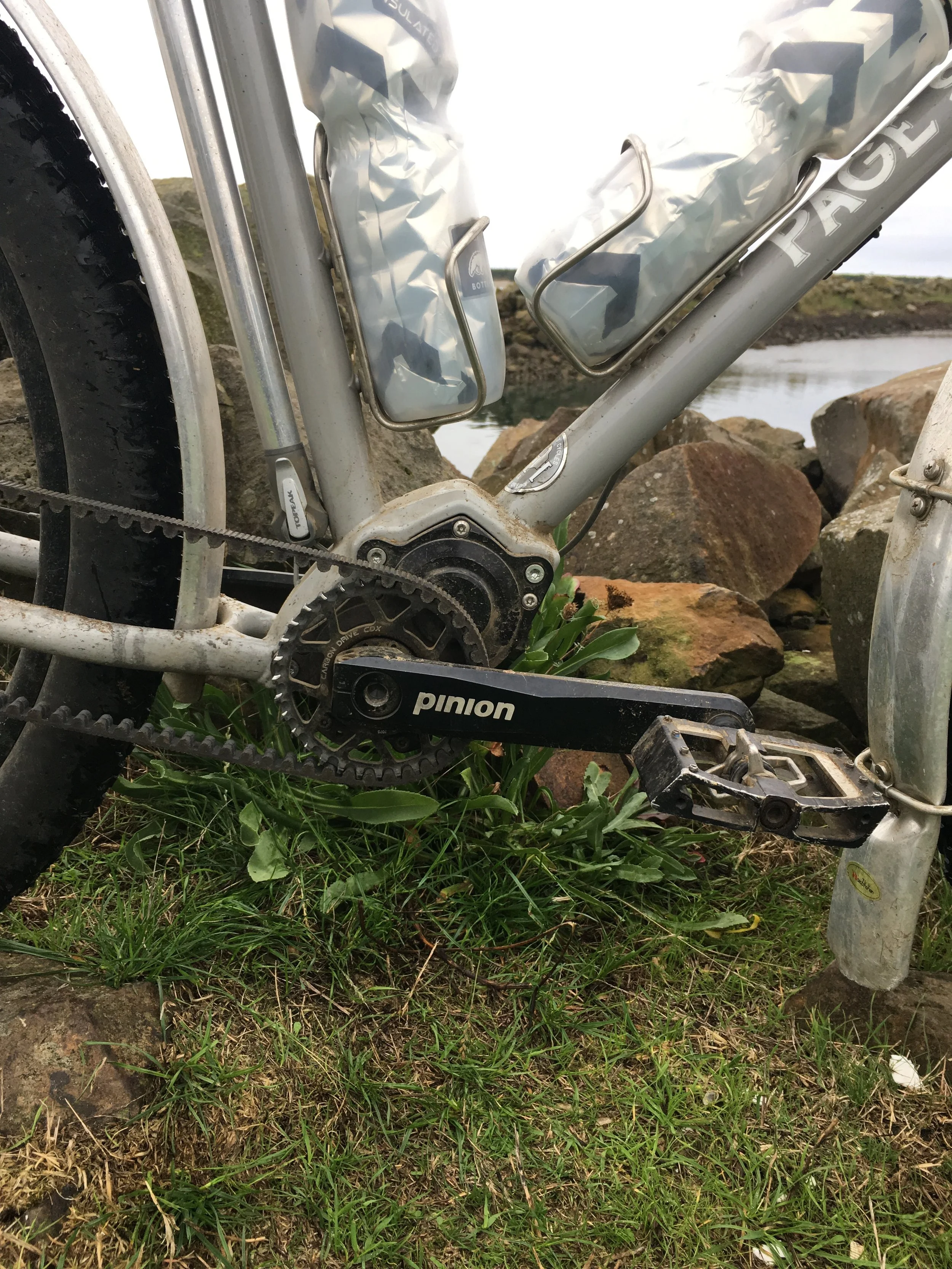
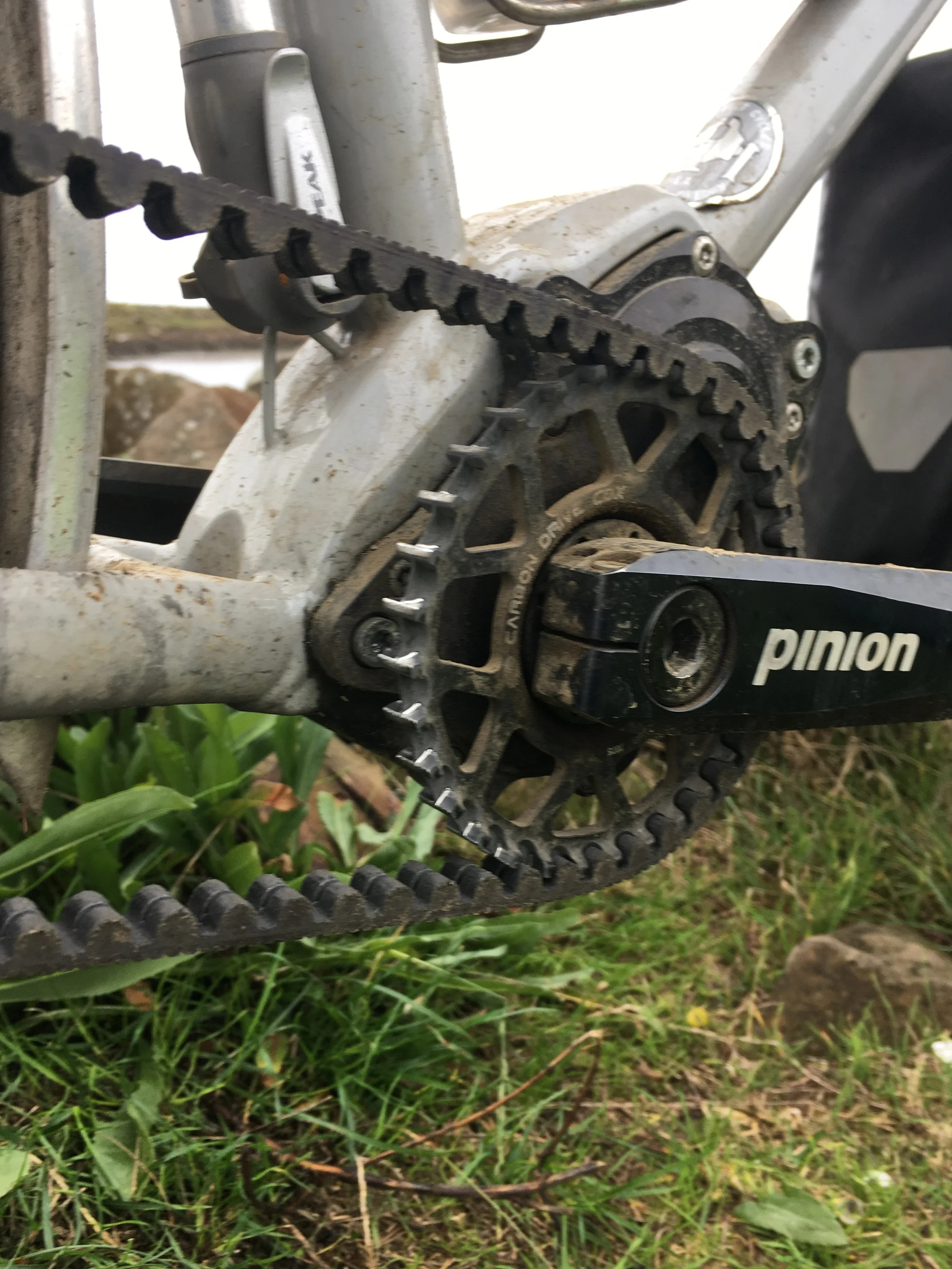

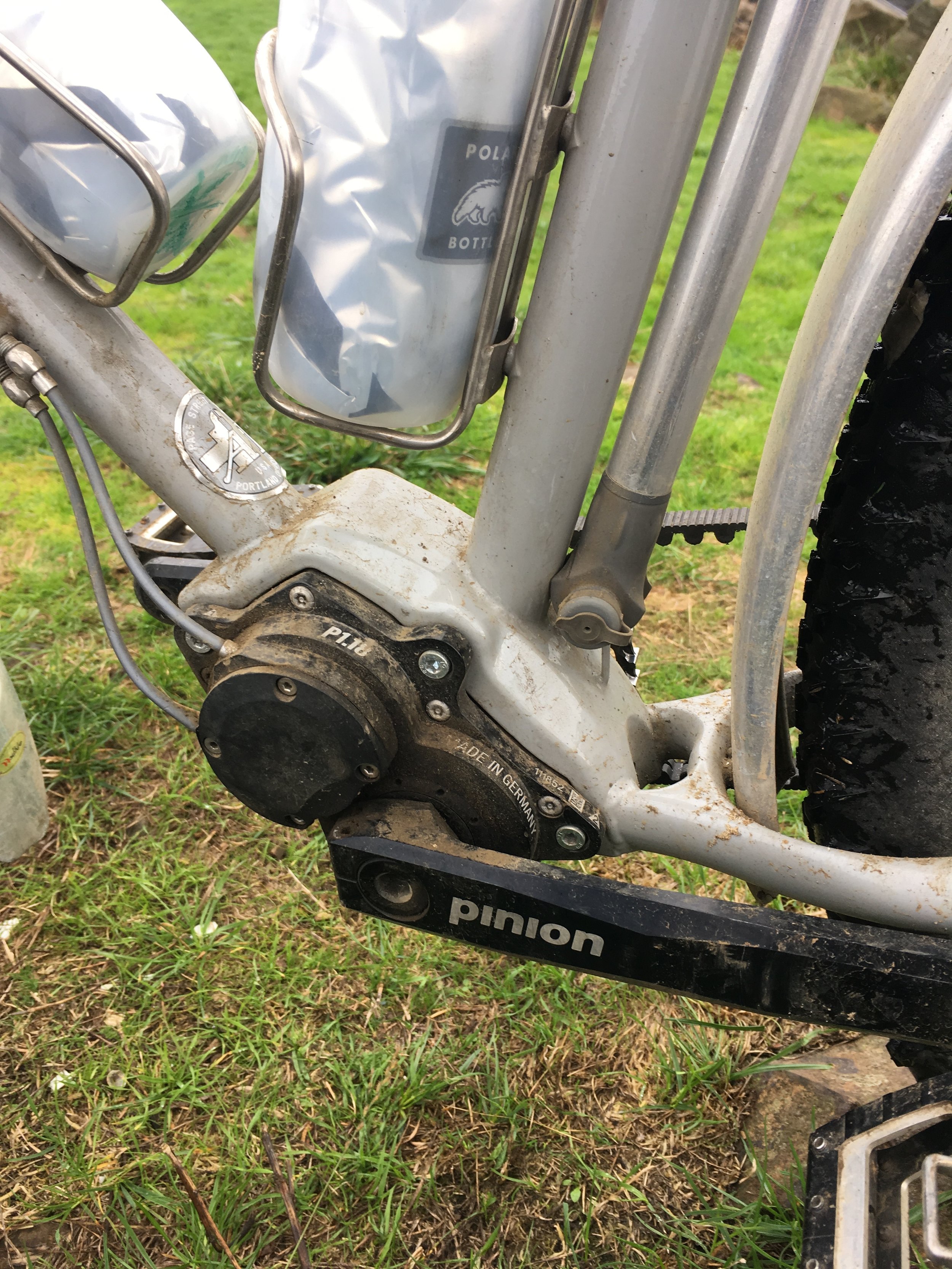
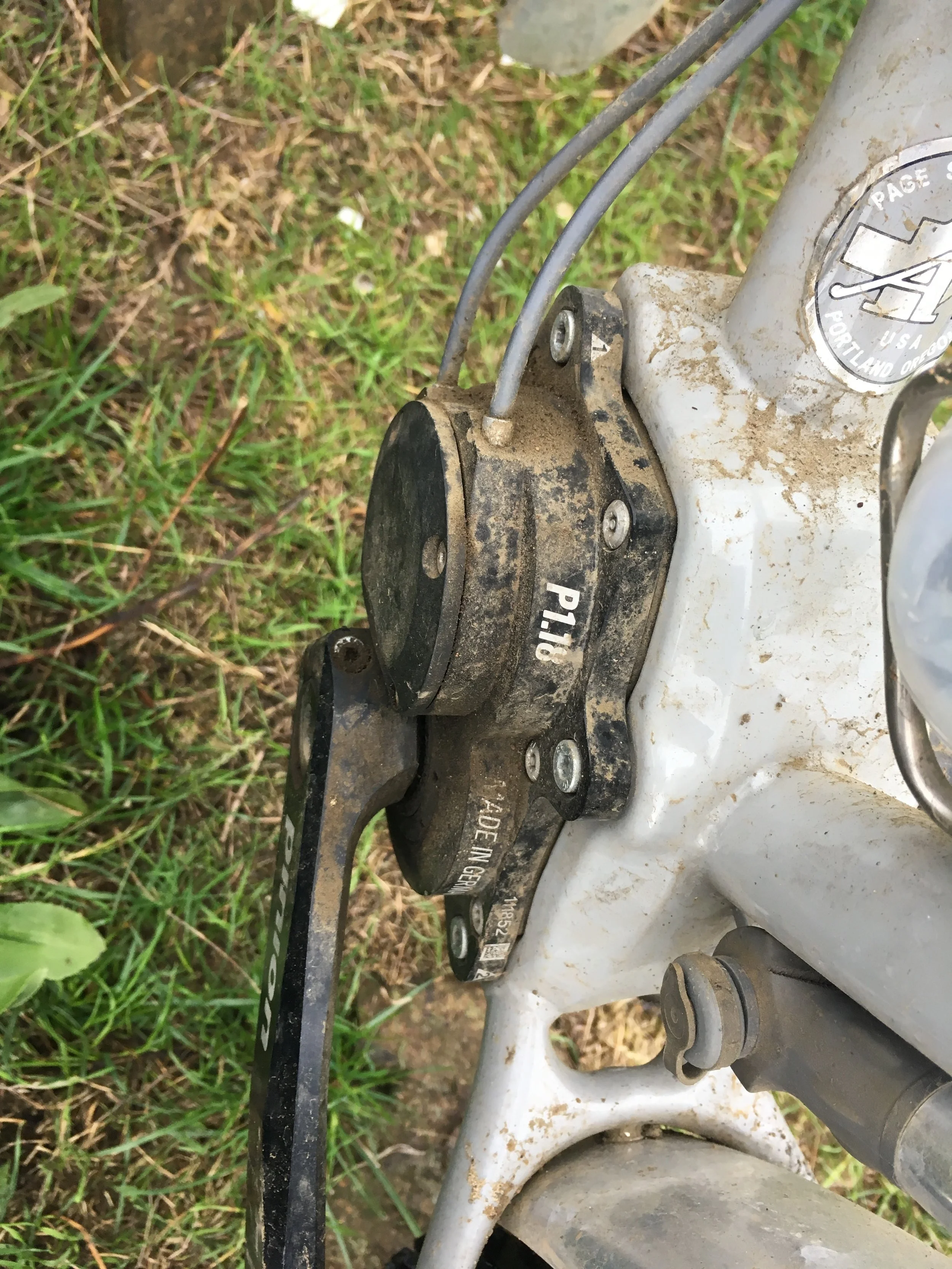
The one down-side to my drive train revealed itself on this trip. With all the dust from the gravel roads my belt started making sounds where it interfaced with the cogs. As I climbed, introducing more torque, it sounded kind of like a small, hungry bird, incessantly squawking to be fed. It wasn’t a terrible sound because it wasn’t loud, but it was there, and because it was friction based, it could be prevented, or fixed. I squirted a bit of water on the cogs and belt and that helped for a short while, but I think the wet attracted more dust, so that as it dried the sound returned, maybe a bit louder. The sound came mostly on the first day, when it was dry and sunny. The second day, as we got into the clouds we had a light, misty rain, and the sound disappeared.
What I hadn’t done before this trip was to spray my belt with conditioner. You can buy a can of belt conditioner from any auto parts store. Made for fan belts and alternator belts etc., it’s a silicone based spray that reduces friction and keeps a belt quiet. I’ve been riding this bike for three years now, and this would only be the second time I’ve needed to condition the belt.
Brian, on the other hand, forgot to bring chain lube, and after the first couple of hours on the first day his chain became pretty raspy, and with all the dust his shifting became less than optimal. With the Pinion, my shifting never faltered or hesitated at all. And to be honest, if this is the worst I can say about the Pinion drive train, that the belt can squeak when dusty and dry, then there’s really not much wrong. That’s pretty small.
Above the Clouds
During and after each tour I do on my Pinion bike I become more convinced of its usefulness and functionality, and I further appreciate how easy it is. There’s very little to think about, or to worry about, or to maintain. The Pinion pretty much always has the right gear for the moment, and the shifting feels positive and solid.
Please don’t think I’m over the bike chain, though. I’m a traditionalist, too:
Break Time. Again.
There is something very satisfying to me about maintaining a chain-driven bike and keeping it running tip-top. There’s a sound and a feel that you become attuned to and that is unique to each bicycle. It requires the rider use a certain finesse when changing gears, a way of paying attention and interacting with the bike that is a sort of dialogue, and gives a very personal relationship between rider and machine. And you know, just by the way it talks to you, when your bike wants adjustment, cleaning, and love. Lucky for me I have another bike, a bike with a chain that I ride quite a lot, satisfying that part of my cycling life.
The Pinion bike is different.
The Final Mile Was the Most Beautiful
I don’t like to compare them, saying one is better than another. Each of my bikes is a tool that I use and care for. Bikes have a lot of tradition and romanticism and story around what they are, what they do. But in the end, what a bike is, and what it does can’t be separated: In it’s simplest form it is a tool that we use to help us get from this place to that place. Every well made tool has its function. It shines and is a pleasure to use when used as it was intended. And, better still, there is room for everyone in this. Everyone’s experience is subjective, so that what I like about one type of bike may not match what you or someone else has found works for them. It’s not a question of who is right or wrong, it is a question of what your experience has taught you.
For me, for the kind of riding I do, I’ve found the Pinion to be a tool that does its job very well. When I’m touring I feel like I’ve got enough to think about with my route and where I’ll get food and fill up my water and where I’m going to sleep and how I’m going to make it over this next ass-kicking hill. I really don’t want to fuss over my bike if I don’t have to. If it will function well and continually and give me what I need to get from this place to that place without too much hassle, then this concern minimized, and it leaves more room to enjoy other aspects of the trip. Or to brood over my lousy choice in routes.
But that’s another story.


